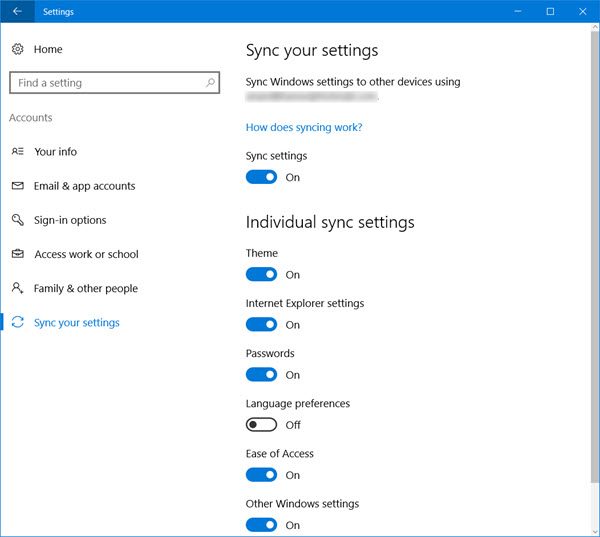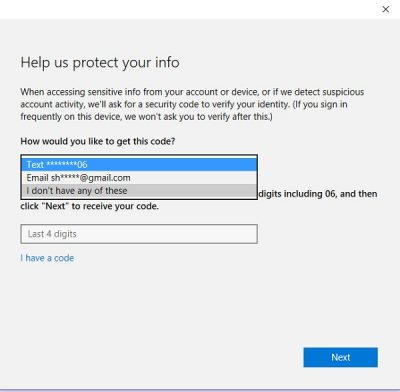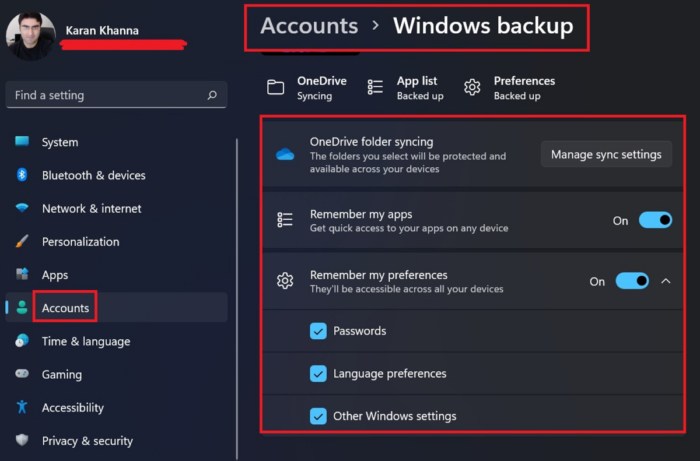Configuring the settings and apps on all your devices is really time-taking and tiresome, this is where the Windows Sync feature comes as a savior. You can sync all your settings and apps across all your Windows devices so that if you ever re-install the operating system, you don’t have to configure them again. The sync settings feature was launched with Windows 8.1 operating system and has always been appreciated by the users. This post will explain how to sync settings in Windows 11/10.
When you turn on Sync Settings on your Windows PC, your operating system takes care of all your settings and sets the same for all your Windows 11/10 devices. You can choose which settings you want to sync across your devices, such as passwords, browser settings, color themes and more.
How to sync your settings in Windows 10
To enable the sync settings, you first need to login into your Windows 10 with the same Microsoft Account on all your devices.

Sync settings are available under the Accounts setting in Windows 10. Open your Settings by pressing Win+I on your Windows 10 PC. Open the Accounts tab and scroll down to select Sync Your Settings.
You can turn Sync on for all settings and apps, or you can decide on your preferences. You can also turn off the Sync settings altogether by turning the Sync button off. Under the Individual Sync Settings tab, you can see different settings options.
Read: How to configure Windows Sync Settings using Registry Editor.
Syncing the Theme setting will synchronize your PC’s background color, theme, etc across all your Windows devices and syncing the Internet Explorer settings will synchronize your bookmarks, log in details, browsing history, etc. However, the default web browser now in Windows 10 is Microsoft Edge and these settings will imply the same.
Next, comes the Passwords. To synchronize your passwords across your Windows devices, you first need to verify your identity. You can get the verification code via your registered phone number or email address. 
The other sync settings let you synchronize the language preferences, ease of access, and other Windows settings which basically include your desktop settings.
Windows 11 is a significant improvement over Windows 10. Many settings were changed, and the focus was on making the approach towards usability much easier. The same happened with the Sync Settings options, which were a part of Windows backup. Both the type of options and the way they are presented have changed.
How to Sync Settings across devices in Windows 11

You can access the Sync settings in Windows 11 as follows:
- Right-click on the Start button and select Settings from the menu.
- Go to the Accounts tab on the list on the left-hand side.
- In the right pane, select Windows backup.
- The option to Sync settings will be on the Windows backup page itself and will work through Microsoft single sign-on.
The settings are as follows:
- OneDrive folder syncing
- Remember my apps
- Remember my preferences
1] OneDrive folder syncing
OneDrive syncs 3 folders by default. These 3 folders are Documents, Pictures, and Desktop. You can use the mentioned options to stop the syncing process for either of these 3 folders. When the options are activated, you will be able to access the contents of these folders on any system where you are logged in with the same Microsoft account.
2] Remember my apps
The Remember my apps option is an excellent way to remember your applications installed on one system to another system where you have logged in with the same account. If the apps are available on the Microsoft Store, then you can reinstall them from the same. It is not available for work and school accounts.
3] Remember my preferences
You can also allow or disallow Windows to remember your passwords, language, and other preferences across systems. This is crucial since passwords entered on one application on one system can be remembered on the same app installed on other devices managed through the same account.
Once turned on, the Sync settings for every app will carry over to all your Windows 11/10 devices where you are logged in with the same Microsoft account.
Sync settings grayed out or not working
Remember that Sync settings are available only if you are logged in with your Microsoft Account. So make sure you are signed in to your PC with your Microsoft account. If it is still not working, try using another Microsoft account. The other things you could try are running System File Checker and DISM.
Should I turn Sync ON or OFF?
Turning Sync ON or OFF is a personal choice, but I usually keep it OFF for crucial data like passwords. However, keeping Sync ON for apps makes it easier to remember the same across systems and install them at the click of a button.
What is the storage size for Sync files?
The storage size for sync files is the same as the size of your OneDrive minus the space you have already used. By default, OneDrive comes with a free space of 5GB. You can increase it to 1TB by purchasing their plan. Unless you have lots of large pictures, this space should be sufficient.
Leave a Reply